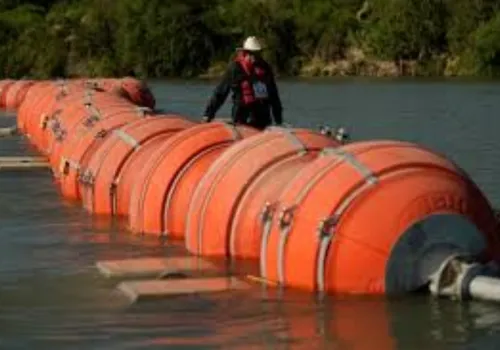
WASHINGTON — The Department of Homeland Security has approved a waiver to expedite construction of a 17-mile waterborne barrier along the Rio Grande in Cameron County, Texas, aimed at bolstering border security.
Signed by Secretary Kristi Noem, the waiver will allow for construction of the RGV Waterborne Barrier Project within the U.S. Border Patrol’s Rio Grande Valley Sector without being held up by environmental or other federal regulations.

This project is the sixth such waiver issued by Secretary Noem since taking office and will utilize funding allocated by FY 2021 U.S. Customs and Border Protection appropriations. Officials expect the contract for the barrier to be awarded by the end of fiscal year 2025.
“In a continuing effort to gain and maintain operational control of the Southern border, and in support of the President’s Executive Orders, CBP continues to look for innovative ways to achieve this mission,” the agency stated.
Waterborne barriers are a response to what DHS has called a "capability gap" in preventing drug smuggling, human trafficking, and illegal crossings in water-rich areas like the Rio Grande. According to the release, these barriers will "create a safer border environment for patrolling agents, as well as deter illegal aliens from attempting to illegally cross the border through dangerous waterways."
Unlike traditional land barriers, waterborne barriers are engineered for aquatic environments, such as rivers and canals, which have been increasingly exploited by smugglers and traffickers due to the lack of physical obstructions.
The Rio Grande—often narrow, unpredictable, and dangerous—is a known hotspot for such activities. Authorities say the new barriers will serve both as a deterrent to unlawful crossings and as a safety enhancement for Border Patrol agents working in treacherous terrain.
The waiver, issued under Section 102 of the Illegal Immigration Reform and Immigrant Responsibility Act of 1996, allows the DHS to bypass certain federal, state, and local laws—including environmental regulations like the National Environmental Policy Act (NEPA)—to accelerate the barrier’s development.
“Projects executed under a waiver are critical steps to secure the southern border and reinforce our commitment to border security,” the DHS stated.
The waterborne barrier project is part of a broader shift toward multimodal border infrastructure—including smart surveillance, autonomous patrols, and environmental adaptation—reflecting the growing complexity of managing the Southern border. With multiple waivers already signed and more projects anticipated, DHS is expected to continue using its authority to expedite high-priority infrastructure aimed at deterring unlawful entry while supporting operational safety.
Originally reported by CPB Govt.